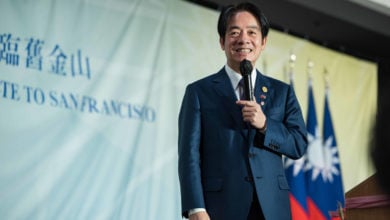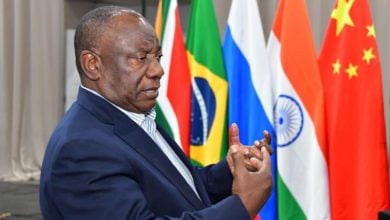On Sept. 3, China celebrated the 70th anniversary of its victory in World War II with a national holiday and a parade in Beijing’s Tiananmen Square. Attended by dignitaries, heads of state and other representatives from across East Asia and around the world, the event nevertheless drew significant controversy, unsurprisingly with the most boisterous criticisms coming from U.S. news outlets. Bloomberg News glibly headlined its coverage as “China Flexes Military Muscle in Victory Day Parade,” albeit with a spurious opener acknowledging that Chinese President Xi Jinping announced that Chinese armed forces would be downsized by 300,000. The “liberal” New York Times’ Andrew Jacobs put out an equally jaded article essentially writing the entire holiday off as a cynical distraction from China’s stock market downturn last month.
Jacobs’ article more or less embodies the U.S. corporate media’s position on China, as well as the outlook of most Washington politicians. As such, it also embodies their historical outlook when it states:
Historians generally agree that the Nationalist armies of Chiang Kai-shek, not Mao’s Communist guerrillas, did the bulk of the fighting against the Japanese. The majority of the estimated three million Chinese soldiers who died from 1937 to 1945 wore the Nationalist uniform, while the Communists, nearly vanquished by Chiang at the time of Tokyo’s invasion, spent most of the war rebuilding behind enemy lines and only occasionally ambushing Japanese troops.
The only reason why Jacobs and others commenting on last week’s parade would include this take on military history is to say that China has no reason to celebrate the Axis defeat, that the Chinese are claiming a victory won by others. This particular argument feeds into the broader assertion that last week’s parade is part of a broader effort by the Chinese government to rewrite history by inflating the Communists’ role in the war.
Refuting the rewriting of history
Our intent is to refute this oppressive counter-factual history with the actual facts of the War of Resistance. This history has been deliberately obscured by anti-Chinese jingoism, but also distorted by years of Cold War-era re-imaginings of the history to lionize the anti-communist Nationalist Party.
The Nationalists, also known as the Guomindang (GMD) or the Kuomintang (KMT), were the ruling party of modern China from the time of Chinese reunification in the 1920’s until their loss to the communists in the Chinese Civil War in 1949. For a brief period during the 1920’s—soon after the GMD’s rise to power over the newly reunified China—the Communist Party of China (CPC) entered into a united front with the GMD on the basis of building national unity in face of imperialist encroachment by Japan, the United States and a variety of European countries, all of which had been slowly dismembering China into colonial spheres of influence since the 1830’s not unlike how Africa was divided in the late 1800s. At the time, the CPC’s position was that its primary task was the defense of China as an oppressed country against imperialism and colonialism.
This united front was broken by the GMD in 1927 with the Shanghai Massacre, when the GMD suddenly banned the CPC and executed more than 10,000 Communists in the 20 days following the decree and up to 300,000 during the year afterward. This marked the beginning of the Chinese Civil War between the Nationalists and the Communists.
Civil war in China
At the beginning of the war with Japan in 1936, the Civil War was in full swing. Over the decade, Japan had been gradually colonizing regions of China, using a series of smaller provocations as pretenses to escalate to relatively low-level military operations in an effort to gradually subsume parts of China one piece at a time. By 1936, all of Manchuria had been captured, and a full-scale Japanese invasion was widely anticipated by Chinese leaders, nationalist and Communist.
Despite the imminent invasion, Chiang Kai-Shek, the chairman of the GMD, refused to cease hostilities with the Communists, later stating, “The Japanese are a disease of the skin; the Communists are a disease of the heart.” In December of 1936, however, Chiang was kidnapped by other members of the GMD and forced to enact a second united front with the CPC.
The GMD’s general mismanagement of government affairs in addition to Chiang’s obsession with the most aggressive and extreme prosecution of the war against the Communists left the official Chinese army and economy woefully unprepared for war against the modern and highly organized armies of Japan. Whereas Japan entered the war as a powerful, industrialized power, China only produced 0.4 million metric tons of steel in 1936 (Germany produced 27 million metric tons of steel that same year). Corruption played a major role in hobbling the Chinese economy throughout the 1930’s, as the GMD sought to strengthen its weak hold on power by allying itself with criminal gangs in major cities. Notably, the GMD built close relations with the Green Gang in Shanghai to build the Greens into a paramilitary-style police force in the city as well as a source of revenue through the Green Gang’s connection to the opium trade. Cooperation with criminal organizations extended beyond Shanghai due to the GMD’s weak overall grasp on power, prompting it to devolve power to local warlords, who loosely enforced GMD policy in exchange for tax enforcement privileges, access to military resources and other perks.
Nationalists weak in military terms
Militarily the Nationalists were also in poor shape. At the outbreak of war, the GMD had no mechanized divisions, almost no armored forces and were suffering from low morale from the longstanding civil war. Poor organization in addition to equipment shortages and failures left only about 1 in 10 divisions in fighting condition. Poor rationing and equipment also led 1.5 million conscripts (about 10 percent) to die of starvation or illness before reaching their units.
The Japanese military, on the other hand, was highly experienced after decades of aggressive colonial expansion and boasted a modern air force and significant armored forces. Perhaps the GMD’s greatest asset was a handful of infantry divisions which were trained by German advisers soon after the Nazis’ rise to power in 1933. These German-trained divisions made up the elite forces of the Nationalist army and were meant to be the new guard in a general modernization plan set up by the German advisers. Due to interference by the warlords, however, the modernization plan was never completed. As a result, relatively few divisions received modern training and equipment, whereas most were made up of poorly trained and equipped conscripts and were commanded in large part by warlords.
These German-trained divisions were deployed to Shanghai in August of 1937 following the capture of most of northern China in the early stages of the war. The GMD planned on making a decisive stand at Shanghai in order to stalemate the Japanese and to prompt western intervention. Nevertheless, the Nationalists’ elite forces were overrun in what became one of the largest and bloodiest battles of World War II. The defeat of the Nationalists’ best forces crippled the Nationalist army. Moreover, it showed that conventional resistance to the superior Japanese forces was untenable and that the Japanese conquest could only be stopped by unconventional methods.
GMD strategy: Wait for Western intervention
After the Battle of Shanghai, the Nationalist strategy was to slowly retreat into the interior of China and wait for Western intervention. After the defeat, the Nationalists made no serious efforts to stop the Japanese advance, preferring instead to slow it by sending small forces over an extended period of time to engage in skirmishes that almost always ended in defeat. Notably, waiting for Western intervention became the Nationalist strategy in 1937, long before there was any indication that the West would become involved. In fact, it was only after the Dec. 7 attacks on Pearl Harbor, the Philippines, Malaya and elsewhere that the West started hostilities with Japan.
The Nationalists’ strategy also made room for preparations to fight the Communists. According to Edward Rice, a foreign service officer in China during War of Resistance, Chief American adviser to the Nationalist Army Joseph Stillwell found Chiang “was unwilling to commit his troops against the Japanese because he was saving them for use against the Chinese Communists. He had 500,000 of his best troops blockading the area occupied by the Chinese communists.” (China: A Century of Revolution, available online)
The communist Chinese Red Army had gained significant experience using guerrilla warfare in the civil war, and following the uneasy united front began applying this experience to resist the Japanese invasion.
Communist strategy: Self-reliance and people’s war
Contrary to the Nationalists’ strategy of waiting for the United States and other western powers to intervene, the CPC adopted a strategy of self-reliance and people’s war. According to this doctrine, China could not rely on superior military forces due to the strength of the Japanese Army, nor on far-off western intervention. Rather, it sought to leverage China’s greatest strategic asset: widespread opposition to the Japanese invasion and occupation. The bulk of the Red Army’s activity consequently took place behind enemy lines, ambushing Japanese forces, disrupting supply and reinforcement convoys, sabotaging equipment and a variety of other guerrilla tactics.
These military operations were supplemented with vigorous political activity to win over the majority of the Chinese people. The Communists expanded agitation among the peasantry and built up liberated zones—areas free from Japanese or Nationalist control.
The Red Army recruited and trained in the liberated zones, and the CPC encouraged economic growth and development to keep the resistance clothed, fed and armed. As a result, the CPC enacted land reform, redistributing land to the peasants and bolstering support for the resistance.
Prolific and massive Japanese atrocities further drove the Chinese masses into resistance. The most infamous example is the Rape of Nanjing, in which the Imperial Japanese Army killed up to 300,000 prisoners and civilians and raped between 20,000 and 100,000 women. Brutality, albeit on a smaller scale, was commonplace throughout the occupation, as the Japanese Army conscripted Chinese people into human experiments and slave labor.
The combination of unthinkable brutality by the Imperial Japanese Army and efforts at developing and liberating China by the Communist Party made for a formidable country-wide resistance movement. This resistance forced a stalemate beginning in 1939. Although Japan responded with massive air raids on civilian targets, the will of the Chinese resistance could not be broken.
Anxiety over the communists’ growing popularity led to increasingly sectarian behavior by the Nationalists, eventually culminating in the New Fourth Army incident, in which the 80,000-strong Eighth Army under Nationalist command encircled and attacked the Communist Fourth Army during a pre-negotiated troop movement. This formally marked the end of the collaboration between the CPC and the GMD during the war of resistance.
The remainder of the war saw little expansion of the Japanese occupied territory due to continued resistance efforts, but Nationalist orientation only became stronger with the entrance of the United States and the British Empire in December 1941. Despite material assistance and close collaboration with the Allies, the Nationalists tried and failed several times to connect with the Allies in India.
This and a string of other failures shows clearly the decisive role played not by Nationalist, but by Communist forces in winning the war against Japan. The only way far-right historians in the United States and Japan are able to pass the Nationalists off as the true victors of the War of Resistance is by manipulating and selectively highlighting data. One trend, for example, is to judge contribution to the War of Resistance by the number of casualties suffered, effectively erasing the number of civilians killed or injured in resistance activities, which are generally not considered explicitly combat operations.
Understanding the role of the Chinese communists in resistance is important not just from an academic point of view, but also in terms of appreciating the genuinely emancipatory character of the Chinese Revolution. To downplay the role of the communists is to downplay the role of popular resistance to Japanese colonialism and brutality. It serves only the most reactionary and far-right agendas to omit the true role of the resistance, since it denies the Chinese people their powerful role in history.
Regardless of their opinion on Chinese socialism, all people should recognize the justice behind the holiday celebrations honoring the 70th anniversary of the end of World War II and honor the role played by the Chinese Communists in organizing the mass resistance.





